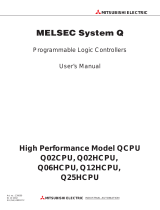
15
TERMS
Unless otherwise specified, this manual uses the following terms.
Term Description
Baton pass A token to send data over a network
Buffer memory A memory in an intelligent function module, where data (such as setting values and monitoring values) are stored.
When integrated into the CPU module, this memory refers to a memory for storing data such as setting values and
monitored values of the Ethernet function, and data used for data communication of the multiple CPU system function.
Control CPU A CPU module that controls connected I/O modules and intelligent function modules.
The multiple CPU system allows the user to set a CPU module to be controlled on a module-by-module basis.
Control station switching time Time from when the control station goes down due to power-off to when the data link is started at the sub-control station
Control system A system that controls a redundant system and performs network communications in a redundant system
Cyclic transmission A function by which data are periodically exchanged among stations on the same network using link devices
Dedicated instruction An instruction that simplifies programming for using functions of intelligent function modules
Device A memory of a CPU module to store data. Devices such as X, Y, M, D, and others are provided depending on the
intended use.
Engineering tool A tool used for setting up programmable controllers, programming, debugging, and maintenance
Global label A label that is valid for all the program data when multiple program data are created in the project.
There are two types of global label: a module specific label (module label), which is generated automatically by GX
Works3, and an optional label, which can be created for any specified device.
Group number Number that is assigned for transient transmission to any given stations.
By specifying a group of stations as transient transmission target, data can be sent to the stations of the same group
number.
Intelligent function module A module that has functions other than input and output, such as an A/D converter module and D/A converter module
Link device A device (LB, LW, LX, LY, SB, and SW) in the MELSECNET/H network module
Link refresh Data transfer between a link device in a network module and a device in a CPU module. Link refresh is performed in the
END processing of the CPU module's sequence scan.
Link scan (link scan time) Time required for all the stations on the network to transmit data.
The link scan time depends on data volume and the number of transient transmission requests.
Logical channel An input channel that can be changed by a program. Eight channels are available. The channel number can be changed
up to 64 by changing the link special register value.
A channel number to be used when the receiving station selects send messages it receives because many types of
information is involved. The sending station corresponds to a broadcasting station distributing messages to the logical
channel, and the receiving station corresponds to a TV receiver used in general households that receives messages by
switching the logical channel.
MELSECNET/10 mode A mode used to operate the MELSECNET/H network module in the MELSECNET/10 network
MELSECNET/H extended mode A mode in which the maximum number of link points per station in the MELSECNET/H mode is extended.
Values exceeding 2000 bytes to maximum 35840 bytes can be set.
Set this mode for the system where the number of link points per station is large.
MELSECNET/H mode A mode used to operate the MELSECNET/H network module in the MELSECNET/H network
Module label A label that represents one of memory areas (I/O signals and buffer memory areas) specific to each module in a given
character string.
For the module used, GX Works3 automatically generates this label, which can be used as a global label.
Multiple CPU system A system where two to four CPU modules separately control I/O modules and intelligent function modules
Normal station A station that performs cyclic transmission and transient transmission with the control station and other normal stations
Process CPU (redundant mode) A Process CPU operating in redundant mode.
A redundant system is configured with this CPU module. Process control FBs and the online module change function
can be executed even in this mode.
Redundant system A system consisting of two systems that have same configuration (CPU module, power supply module, network module,
and other modules). Even after an error occurs in one of the two system, the other system takes over the control of the
entire system.
Relay station A station that includes two or more network modules. Data are passed through this station to stations on other networks.
Reserved station A station reserved for future use. This station is not actually connected, but counted as a connected station.
Standby system A backup system in a redundant system
System A A system that is set as system A.
Redundant system consists of system A and system B. The name of system A is used to distinguish these connected
two systems.
System B A system that is set as system B.
Redundant system consists of system A and system B. The name of system A is used to distinguish these connected
two systems.























